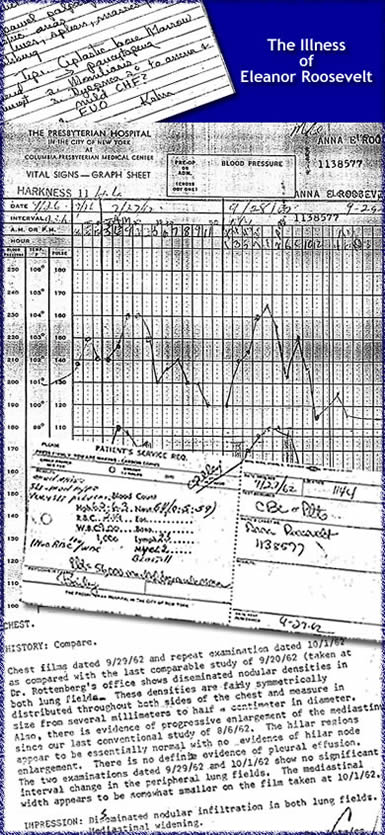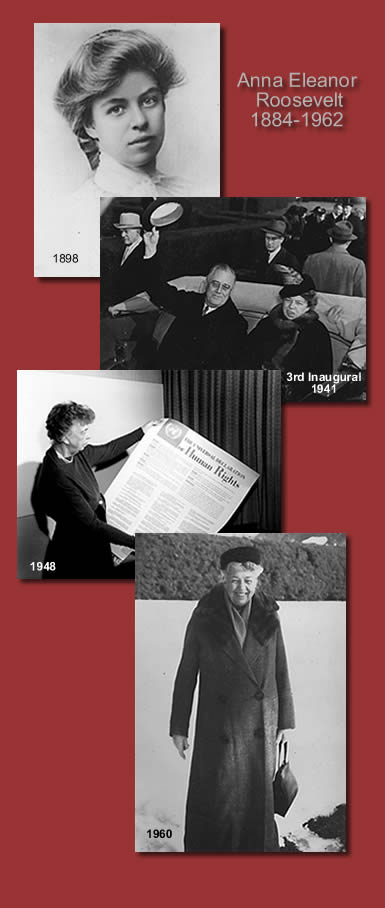Infectious Diseases Case of the Month Case #28 |
|||
 |
4th of July Special EditionEleanor Roosevelt, 77 years old, former U.S. First Lady, was admitted to the hospital on 26 September 1962 suffering with fever, gastrointestinal bleeding, and severe anemia. This was the third hospitalization for Mrs. Roosevelt since the preceding September. She had first been discovered to be anemic in April 1960 when routine laboratory testing revealed a Hgb of 10. A bone marrow aspiration done when anemia persisted showed hyperplasia and 18% myeloblasts. Her physicians concluded that she likely had aplastic anemia not leukemia. She continued her active life style including international travel. Her past was notable for vigorously good health although she had had an episode of prolonged pleurisy in 1919. As a young woman she had regularly visited the tenements of New York City where she had attempted to aid the less fortunate. This interest had persisted throughout her life and may often have placed her both at home and abroad in situations where she had heightened potential exposure to infectious disease. During World War II she extensively toured the Pacific Theater visiting with U.S. servicemen. Her first hospitalization had been in September 1961 for vaginal bleeding at which time she was also discovered to be pancytopenic (Hgb 8, WBC 1.5, Plts 79). A bone marrow aspirate then showed hypoplasia and 5% myeloblasts. During subsequent months she required periodic blood transfusions for significant anemia. In February 1962 she was placed on prednisone in treatment of her apparent aplastic anemia. She was readmitted in August 1962 for fever to 40.5C and complaints of dry cough and sweats. An ESR was 128; CXR was negative except for calcified hilar lymph nodes. At the time of her September 1962 admission she was having black, tarry stools and weakness with high fevers. Her Hgb was 5,3, WBC 2.2, and her CXR now showed ill defined nodular densities. Barium studies of her intestines did not reveal a cause of her bleeding. Given the the persistence of fever (since at least July) her physicians now considered her illness a case of fever of unknown origin (FUO). Another bone marrow aspiration was performed again with findings of hypocellularity and 6% blasts. AFB smear on the bone marrow aspirate was negative. Because of concern that she might be suffering from tuberculosis (reactivation from her illness in 1919), she was begun on isoniazid (INH) and twice daily injections of streptomcyin. She remained ill with fevers and eventually insisted on hospital discharge (16 October). At discharge in addition to her anti-tuberculosis drugs she was discharged on prednisone at 60mg per day. Her physicians were very encouraged to learn on the 26th of October that culture from her bone marrow was growing Mycobacterium tuberculosis in that they hoped that she would respond to her therapy for TB. Unfortunately, she continued to deteriorate. Despite having received 6 weeks of anti-tuberculous therapy, she suffered an apparent stroke on November 4, 1962, became comatose, and passed away on November 7. The family consented to an autopsy.
|
||
What was the likely cause of Eleanor Roosevlelt's illness? |
|||
 |
Eleanor Roosevelt died of disseminated tuberculosis. At autopsy tuberculous disease was discovered to be so widely disseminated that pathologists described her condition as disseminated tuberculosis acutissima which connotes overwhelming infection. Tuberculosis bacilli were found in lung, bone marrow, spleen, liver, and kidneys without the formation of granulomatous inflammation that occurs most typically with infection with Mycobacterium tuberculosis. Presumably underlying hematologic illness and steroids contributed to the extent of her illness and her ultimate demise. It was speculated that her illness represented reactivation disease perhaps from illness originally contracted at the time of her 1919 pleurisy. Treating physicians were perplexed, however, that she had not responded to the six weeks of specific anti-tuberculous therapy that she had received prior to her death. Surprisingly, the Mycobacterium tuberculosis cultured was found to be resistant to both INH and streptomycin, the drugs with which she had been treated. It is conceiveable that her infection therefore had been much more recent as there was considerable drug resistant TB circulating in the early 1960's (which would not have been present in 1919). Eleanor Roosevelt was one of the most influential and remarkable women of the 20th Century. Born into privilege, the niece of future President Theodore Roosevelt, she nonetheless had a difficult childhood with among other things both parents dying prematurely (her mother to diphtheria and her father to complications of alcoholism). She married her distant cousin (and future U.S. President), Franklin D. Roosevelt, in 1905. She was an active First Lady as she assisted and complemented FDR as they led the United States through the events of the Great Depression and World War II. Eleanor Roosevelt had a lifelong interest in social justice and the welfare of the dispossessed, areas in which she wielded profound influence. Sometimes she exercised her influence through her husband but more often though the force of her own personality and intellect. Notably she advocated for civil rights for American blacks. Famously she intervened when Marian Anderson was denied the opportunity to perform at Constitution Hall when the Daughters of the American Revolution insisted on segregated seating of the audience. Mrs. Roosevelt then helped arrange Ms Anderson's performance at the Lincoln Memorial on Easter Sunday, 1939. One of Eleanor's most significant achievements was chairing the United Nations committee that created the Universal Declaration of Human Rights. That Eleanor Roosevelt died of tuberculosis despite the the evaluation of skilled physicians illustrates how elusive this diagnosis sometimes can be. That she died of drug resistant disease is a cautionary tale for the problem of antimicrobial resistance which is ever more prevalent today. The Case of the Month celebrates the life of Eleanor Roosevelt. Happy 4th of July! Ref: Lerner, B.H., Revisiting the death of Eleanor Roosevelt; was the diagnosis of tuberculosis missed?, Int J Tuberc Lung Dis, 5(12):1080-1085, 2001. |
||
| Home Case of the Month ID Case Archive | Your Comments/Feedback | ||